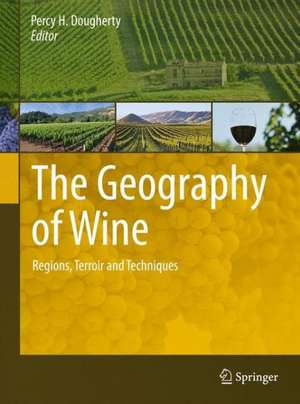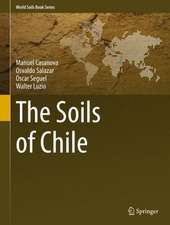The Geography of Wine: Regions, Terroir and Techniques
Editat de Percy H. Doughertyen Limba Engleză Paperback – 24 feb 2014
Geographers have technical input into the wine industry, with exciting new research tackling subjects such as the impact of climate change on grape production, to the use of remote sensing and Geographical Information Systems for improving the quality of crops. This book explores the interdisciplinary connections and science behind world viticulture. Chapters cover a wide range of topics from the way in which landforms and soil affect wine production, to the climatic aberration of the Niagara wine industry, to the social and structural challenges in reshaping the South African wine industry after the fall of apartheid. The fundamentals are detailed too, with a comparative analysis of Bordeaux and Burgundy, and chapters on the geography of wine and the meaning of the term ‘terroir’.
| Toate formatele și edițiile | Preț | Express |
|---|---|---|
| Paperback (1) | 844.65 lei 38-44 zile | |
| SPRINGER NETHERLANDS – 24 feb 2014 | 844.65 lei 38-44 zile | |
| Hardback (1) | 853.15 lei 38-44 zile | |
| SPRINGER NETHERLANDS – 3 ian 2012 | 853.15 lei 38-44 zile |
Preț: 844.65 lei
Preț vechi: 1111.38 lei
-24% Nou
Puncte Express: 1267
Preț estimativ în valută:
161.63€ • 169.18$ • 134.52£
161.63€ • 169.18$ • 134.52£
Carte tipărită la comandă
Livrare economică 26 martie-01 aprilie
Preluare comenzi: 021 569.72.76
Specificații
ISBN-13: 9789401784238
ISBN-10: 940178423X
Pagini: 268
Ilustrații: XII, 256 p.
Dimensiuni: 193 x 260 x 20 mm
Greutate: 0.58 kg
Ediția:2012
Editura: SPRINGER NETHERLANDS
Colecția Springer
Locul publicării:Dordrecht, Netherlands
ISBN-10: 940178423X
Pagini: 268
Ilustrații: XII, 256 p.
Dimensiuni: 193 x 260 x 20 mm
Greutate: 0.58 kg
Ediția:2012
Editura: SPRINGER NETHERLANDS
Colecția Springer
Locul publicării:Dordrecht, Netherlands
Public țintă
Professional/practitionerCuprins
Overview.- 1. Wine and Viticulture: A Geographer’s Perspective.- 2. Terroir: At the Heart of Geography.- 3. Geography and the American Viticultural Areas Process, Including a Case Study of Lodi, California.- Regional.- 4. Bordeaux and Burgundy: A Comparison of Two French Wine Regions in Transition.- 5. The Okanagan Wine Region of British Columbia, Canada.- Physical.- 6. The Importance of Soil and Geology in Tasting Terroir; A Case History from the Willamette Valley, Oregon.- 7. Climate, Grapes, and Wine: Structure and Suitability in a Variable and Changing Climate.- Cultural/Economic.- 8. The South African Wine Industry: Meeting the Challenges of Structural and Ethical Transformation.- 9. Competiveness and Sustainability in Wine Tourism Regions: The Application of a Stage Model of Destination Development to Two Canadian Wine Regions.- 10. Northern California through an Economic Geographer’s Lens.- 11. The Origin, Diffusion, and Globalization of Riesling.-Techniques.- 12. Remote Sensing for Viticultural Research and Production.- 13. Geospatial Tools and Techniques for Vineyard Management in the 21st Century.- Index.
Recenzii
From the reviews:
“This is one of the most interesting books about geography I have read. The story of wine serves to draw the reader into the text and even deeper into the understanding of the influences that geography can play on wine production. … The Geography of Wine: Regions, Terroir and Techniques is well researched and includes much detail about wine and geography. If you know little or a lot about wine, this book will be interesting and well worth the read … .” (Jeff Thurston, 3D Visualization World Magazine, 3dvisworld.com, October, 2012)
“This is one of the most interesting books about geography I have read. The story of wine serves to draw the reader into the text and even deeper into the understanding of the influences that geography can play on wine production. … The Geography of Wine: Regions, Terroir and Techniques is well researched and includes much detail about wine and geography. If you know little or a lot about wine, this book will be interesting and well worth the read … .” (Jeff Thurston, 3D Visualization World Magazine, 3dvisworld.com, October, 2012)
Notă biografică
The editor, Dr. Percy H. Dougherty, is Professor Emeritus at Kutztown University in Pennsylvania. He is the founder and first president of the Wine Specialty Group of the Association of American Geographers.
Textul de pe ultima copertă
Wine has been described as a window into places, cultures and times. Geographers have studied wine since the time of the early Greeks and Romans, when viticulturalists realized that the same grape grown in different geographic regions produced wine with differing olfactory and taste characteristics. This book, based on research presented to the Wine Specialty Group of the Association of American Geographers, shows just how far the relationship has come since the time of Bacchus and Dionysus.
Geographers have technical input into the wine industry, with exciting new research tackling subjects such as the impact of climate change on grape production, to the use of remote sensing and Geographical Information Systems for improving the quality of crops. This book explores the interdisciplinary connections and science behind world viticulture. Chapters cover a wide range of topics from the way in which landforms and soil affect wine production, to the climatic aberration of the Niagara wine industry, to the social and structural challenges in reshaping the South African wine industry after the fall of apartheid. The fundamentals are detailed too, with a comparative analysis of Bordeaux and Burgundy, and chapters on the geography of wine and the meaning of the term ‘terroir’.
The editor, Dr. Percy H. Dougherty, is Professor Emeritus at Kutztown University in Pennsylvania. He is the founder and first president of the Wine Specialty Group of the Association of American Geographers.
Keywords: viticulture, terroir, climate change, remote sensing, wine
Geographers have technical input into the wine industry, with exciting new research tackling subjects such as the impact of climate change on grape production, to the use of remote sensing and Geographical Information Systems for improving the quality of crops. This book explores the interdisciplinary connections and science behind world viticulture. Chapters cover a wide range of topics from the way in which landforms and soil affect wine production, to the climatic aberration of the Niagara wine industry, to the social and structural challenges in reshaping the South African wine industry after the fall of apartheid. The fundamentals are detailed too, with a comparative analysis of Bordeaux and Burgundy, and chapters on the geography of wine and the meaning of the term ‘terroir’.
The editor, Dr. Percy H. Dougherty, is Professor Emeritus at Kutztown University in Pennsylvania. He is the founder and first president of the Wine Specialty Group of the Association of American Geographers.
Keywords: viticulture, terroir, climate change, remote sensing, wine
Caracteristici
Discussion on how the geography of an area has an impact on the type of wine produced in an area and how geographers study wine production Analysis of the regions in which grapes and wine are produced Use of new research ranging from the impact of climate change on grape production to the use of remote sensing and Geographical Information Systems in improving the quality of the crop Overview of the status of wine research in geography and recent research that has been presented through the Wine Specialty Group at the Annual Meetings of the Association of American Geographers









